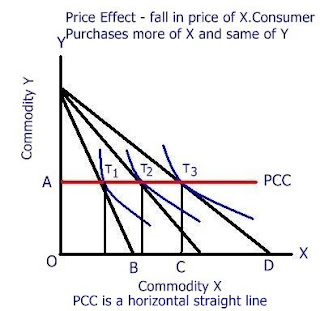Equilibrium position: Under the Price Effect, there will be a change in the equilibrium position of the consumer. This can be shown in the following diagram.

In this diagram PCC is the Price Consumption Curve. It is sloping downwards to the right. Any point on the Price Consumption Curve will indicate the equilibrium position of the consumer under the Price Effect. In this diagram when the price of X falls, the consumer purchases more of X and less of Y.
Shapes of Price Consumption Curve
With a fall in the price of one commodity there will be some extra income with the consumer. It can distribute this real extra income on the two commodities in different ways. So the Price Consumption Curve will have different shapes. Below we draw the different shapes of the Price Consumption Curve.

In the above diagram PCC is the price consumption curve. It is a horizontal straight line. It indicates that with a fall in the price of X, the consumer purchases more of X and the same quantity of Y

In the above diagram PCC, the price consumption curve, is sloping upwards to the right. This indicates that with a fall in the price of X the consumer purchases more of X and more of Y.

In this diagram the price consumption curve is sloping upwards to the left. This indicates that with a fall in the price of X, the consumer purchases less of X. This is applicable in case of Giffen goods.
Mr. Robert Giffen made a survey in Ireland in the 19th century and found out that the people of Ireland spent major portion of their income on potatoes and meat. He also observed that when there was a rise in the price of potatoes, people purchased more potatoes. Because they did not have sufficient income to purchase sufficient quantity of meat and potatoes. Since potatoes were more essential to them, they purchased more potatoes and less meat. So those commodities, which are purchased more even when there is a rise in the price, they are known as Giffen goods.
Substitution Effect
Income Effect

Hi! Would you mind if I share your blog with my facebook group?
ReplyDeleteThere's a lot of folks that I think would really appreciate your content. Please let me know. Thanks
My page - take surveys online for money free
I do not mind your sharing with your Facebook group. This blog is meant for all who need the contents and like the subject Economics. So go ahead and share freely!!!!!!!!! dear friend.
DeleteThank you very much! This aided my understanding.
ReplyDeleteDear Mr Chandra,
ReplyDeleteI need your permission to use the material on your blog for purely academic purpose, for the benefit of my students at DU. Please keep up the good work. Waiting for your response
Thanks!!!!! You can always use any post, any material from here for all your educational purposes. After all it is primarily meant for use by students. That would be my pleasure. Sorry for being late in replying.
DeleteSir when pcc is parllel to oy-axis?
ReplyDeleteIt is parallel to the Y axis as the consumer purchases same quantity of commodity Y but more of commodity X.
Delete